Request for Jesuit Home To Be Reconsidered
Ann Arbor planning commission meeting (June 3, 2014): A controversial request to allow up to six Jesuits to live together at 1919 Wayne St. did not secure sufficient votes for approval from Ann Arbor planning commissioners at their June 3 meeting. A vote by commissioners came after about an hour of public commentary and two hours of deliberations.
However, at the end of the meeting – near midnight, long after supporters and opponents of the proposal had left – commissioners voted to reconsider the item, and then subsequently voted to postpone action until their next meeting on June 17.
The request – by the Ann Arbor Jesuit Community, formally known as the USA Midwest Province of the Society of Jesus – is for a special exception use to allow a “functional family” to live in a house zoned R1C (single-family dwelling). Without the special exception use, only up to four unrelated people could live there.
The code that allows this special exception use was adopted by Ann Arbor in 1991. Although the city’s ordinance has allowed for a “functional family” designation for more than two decades, this is the first time any group has requested it. The members are affiliated with the St. Mary Student Parish.
Approval required six votes, but the request initially garnered support from only five of the seven commissioners who were present. Voting against it were Diane Giannola and Kirk Westphal. Two commissioners – Sabra Briere and Paras Parekh – were absent. An attempt earlier in the meeting to postpone the vote had failed, with a majority of commissioners wanting to take action that night, apparently assuming it would pass. The final vote to postpone – taken after all other agenda items were dispatched – was 6-1, over dissent from Giannola. The planning commission has discretion to grant a special exception use, which does not require additional city council approval.
During the proposal’s public hearing, 21 people spoke – the majority of them opposed to the request, including representatives from the Oxbridge Neighborhood Association and the North Burns Park Association. Concerns included the possibility of lower property values, the chance of opening the door to student housing or cults, instability of the household because members aren’t related, and “gender housing discrimination.”
Some people directed criticism against the power, privilege and abuse of the Catholic church. Other praised the Jesuits, saying their concerns were strictly related to the zoning code, which they didn’t feel permitted this type of living arrangement in the R1C district. They suggested that the Jesuits could live in other districts – like R4C – that would allow for up to six unrelated people to live together without getting a special exception use.
Three Jesuits who plan to live there – including Ben Hawley, pastor and director of campus ministry for the St. Mary Student Parish – attended the meeting. Rev. Daniel Reim, who serves as the head of household, apologized for the controversy that this request has caused. The group currently lives in a smaller house on Ferdon, which they said they’ve outgrown. Some supporters of the request noted how the men are good neighbors on Ferdon. The former owner of that house pointed out that nearby properties he’s built or renovated had sold for over $1 million, describing the argument about hurting property values as “silly.”
The public hearing will be re-opened on June 17, to allow for additional public input. The Jesuits are encouraging supporters to attend. On June 9, Reim sent an email suggesting specific ways that people can lobby commissioners and the city council.
In voting against the request, Giannola said she didn’t think the Jesuits fit the description of a “functional family.” Westphal said he wanted to get more information from the city attorney’s office about the risk of setting a precedent, and whether there could be conditions on the special exception use that would address concerns about the turnover of residents. Planning staff reported that the city attorney’s office had already vetted the item, but they would make additional queries based on commissioners’ feedback.
There was some question about whether a delay would affect the sales contract that the Jesuits have with the current owner, who also attended the June 3 meeting. The property is listed for sale at $795,000.
In taking up the issue on June 17, one additional wrinkle might be the composition of the commission at that meeting. Two commissioners who supported the request – Jeremy Peters and Eleanore Adenekan – indicated that they would be absent, and another supporter, Ken Clein, said he might also be unable to attend. So it’s possible that there will only be six commissioners at that meeting. That would mean all six commissioners would need to vote yes in order for the request to win approval.
The property is located in Ward 2. One of the Ward 2 city councilmembers, Jane Lumm, attended the planning commission meeting, but did not formally address the commission. Westphal – the planning commission’s chair – is running for city council in the Ward 2 Democratic primary. Westphal and Nancy Kaplan are vying to fill the open seat that’s being left by Sally Petersen’s mayoral candidacy.
In other action on June 3 – a meeting that lasted over five hours – commissioners postponed a rezoning and site plan request from the Ann Arbor housing commission for a property on North Maple, part of a major overhaul of the city’s public housing sites. The project would demolish the single family homes at North Maple Estates, and build apartments that would roughly double the density of low-income housing there. Some neighbors raised concerns about the proposal, which is on the commission’s June 17 agenda for consideration.
Other items on the June 3 agenda were dispatched with little discussion: (1) a site plan for Dusty’s Collision on South Industrial; (2) an expansion at the Rudolf Steiner High School on Pontiac Trail; and (3) a rezoning and area plan request to develop property on Research Park Drive, including an indoor-outdoor tennis facility.
Jesuit Home on Wayne Street
Planning commissioners were asked to consider a request that would allow up to six Jesuits to live together at 1919 Wayne St.
The request – by the Ann Arbor Jesuit Community, formally known as the USA Midwest Province of the Society of Jesus – is for a special exception use to allow a “functional family” to live in a house zoned R1C (single-family dwelling). Without the special exception use, up to four unrelated people could live there.
The code that allows this special exception use was adopted in 1991. Before that time, most communities didn’t provide for an alternative family living arrangement in their zoning codes. In 1984, the Michigan Supreme Court determined that some provision for a living arrangement other than a traditional biological family was needed. That ruling came in the case of Delta Charter Township v. Dinolfo.
Ann Arbor adopted language that is similar to ordinances in many communities in Michigan. A group must meet all requirements in the zoning ordinance as well as in the special exception use conditions in order to be considered a “functional family.” A “functional family,” for purposes of the city’s zoning code, is defined as follows: “a group of people plus their offspring, having a relationship which is functionally equivalent to a family. The relationship must be of a permanent and distinct character with a demonstrable and recognizable bond characteristic of a cohesive unit.” The city code states that a functional family is not a social society, club, fraternity or sorority, association, lodge, organization, group of students or other unrelated persons living together temporarily.
The permit must apply only to the functional family “type” that obtains the permit – in this case, the Ann Arbor Jesuit Community. It is limited to the number of people specified in the permit, and there must be a contact person identified as head of household. This special exception use would be limited to up to six people, with Rev. Dan Reim acting as head of household.
Although the city’s ordinance has allowed for a “functional family” designation since 1991, this is the first time any group has requested it. The residents would be members of the religious order at St. Mary’s Student Parish, or pursuing degrees at the University of Michigan or other local institutions.
The group’s application describes how the Jesuits live as a “functional family.” The statement reads, in part:
As a functional family, we refer to one another, when speaking of each other collectively, as “brothers.” Our unity is based upon our religious commitment to live together as a religious family. As brothers related to one another by our common vows and commitment to service in the Church, we are, like a family, one another’s primary support system.
…
The basis of our living as a household is not temporary or dependent on the University school year or any such seasonal arrangement or pattern, as a fraternity or sorority would typically be. Jesuits living in structured households under a superior has been an integral part of the religious order for centuries, and the Jesuits who will live at 1919 Wayne will be participating in that centuries old tradition.
In addition to meeting the “functional family” requirement, this special exception use must meet with certain standards, including compatibility with the zoning district and adjacent districts. The use must also not generate an intensity that would be hazardous or inconvenient to the neighborhood, or conflict with normal traffic.
Wayne Street is located on the city’s near east side, between Washtenaw Avenue and Vinewood Boulevard, in Ward 2.
No exterior changes are planned to the structure of the house, which has about 4,000 square feet with seven bedrooms and two bathrooms. The Jesuits indicated that they’d like to reconfigure the interior to use one of the bedrooms as a guest room and to add two bathrooms.
The special exception use would be contingent on providing off-street parking spaces for each vehicle used by the residents. There are two spaces in the garage and two tandem parking spaces in the driveway. They also have received permission to park two vehicles at the lot for the First Church of Christ, Scientist, which is adjacent to the site.
In giving her staff report, city planner Alexis DiLeo pointed out that a range of questions raised by nearby residents are addressed in the staff report. [.pdf of staff memo]
The planning commission has discretion to grant a special exception use, which does not require additional city council approval.
Jesuit Home on Wayne Street: Public Hearing
A public hearing drew 21 speakers and lasted about 45 minutes. Several speakers also wrote letters, which were included in the meeting packet. Here are some highlights.
Dan Reim introduced himself as one of the Jesuits who’s applying for the special exception use. He apologized to neighbors for the concerns that this has raised and the tensions that exist. He had hoped to attend the May 13 Oxbridge Neighborhood Association meeting to relieve these concerns. There’s a lot of misinformation and misunderstanding, he said. Reim identified several claims that neighbors have made, such as a negative impact on resale value of nearby homes, and the use of this house for UM Jesuit students. “These statements are not correct,” Reim said. “This is not student housing.”
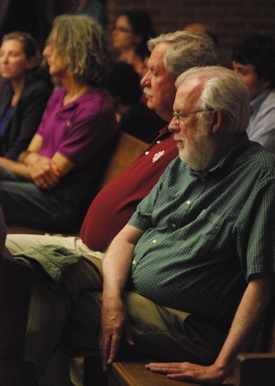
In the foreground is Dennis Dillon, a pastoral associate at St. Mary Student Parish. Next to him is Ben Hawley, pastor and director of campus ministry. Both men would be among the Jesuits living at 1919 Wayne St.
In addition to Reim, other residents at the house would include Ben Hawley, pastor and director of campus ministry for the St. Mary Student Parish, and Dennis Dillon, a pastoral associate. In August, two new Jesuit priests would be arriving, both of them 33 years old. One of them will be starting a doctoral program at UM’s School of Public Health, and would be the only student in the house, Reim said. At this time, only five Jesuits are planning to live at the house. If a sixth person were to come, he would not be a student but would work at the parish, Reim said.
Reim talked about how the group would be like a family, sharing income and expenses. This would be their full-time residence. Chores, meals, recreation and prayers are shared. The head of household is the designated patient advocate, he noted. As religious brothers, they serve as each other’s primary support system. They’ve loved living in their current home on Ferdon, Reim said, where he’s lived for 10 years. But now they need a new home to accommodate more brothers. They’ll do everything they can to be good neighbors, he concluded.
Peter Nagourney told commissioners he’s co-chair of the North Burns Park Association. He was concerned about the precedent that would be set, and he didn’t believe the planning staff’s justification for granting a special exception use was valid. He highlighted a response from the Jesuits that stated the residents “will generally be members of the religious order that serve at St. Mary’s Student Parish…and/or will be pursuing degrees at the University of Michigan or other local institutions.” The term “generally” is non-specific, he said.
What’s more, the residents will be non-permanent, he added, because some residents will be students or interns, who’ll leave after they finish their studies. The occupants will continually change, Nagourney said. He also was concerned because the city doesn’t enforce its ordinances. In addition, he worried that this would set a precedent for other groups to claim similar status, which could in turn hurt property values. A charismatic leader with five followers, a cult or a commune could qualify, he said. So the city is “about to open the doors wide” to any number of other household types in residential neighborhoods. He urged commissioners to reject this request.
Scott Munzel is the attorney representing the Oxbridge Neighborhood Association to oppose the application. [.pdf of Munzel letter] Clearly the applicant is not a functional family, he said. The name of the organization includes the word “society,” he said, and a society is explicitly excluded from the city’s definition of a functional family. The Jesuits take vows, Munzel noted, but those vows are not directed to each other – they’re directed to the church. As an “ironic detour,” he joked, many families actually don’t operate in the way that the Jesuits describe. “Many families operate like a failed autocracy, subject to coup at any moment.”

Peter Nagourney, Scott Munzel and Eppie Potts all spoke against granting the special exception use request for 1919 Wayne St.
Even if the Jesuits were a functional family, Munzel continued, they’d fail to meet the standards of a special exception use, which include protecting the residential fabric of the neighborhoods and maintaining property values. He noted that other residential zoning districts – such as R4C – do allow for six unrelated residents in a home. There are thousands of structures in R4C districts, he said. Munzel also indicated his view that the decision about granting a special exception use is the purview of the zoning board of appeals
Liz Kamali lives in the Oxbridge neighborhood and supported the project. [.pdf of Kamali letter] She noted that her family had joined the Oxbridge Neighborhood Association soon after they moved into the area. But she had grave concerns about how ONA is handling this matter. She said the ONA board had violated its bylaws by not sending timely notice of a May 13 meeting, and it hadn’t been clear that the meeting would include a vote about hiring an attorney. There’s been a lack of communication between ONA and its members, she said. Specifically, the board didn’t notify all members that it was spending members’ money to hire an attorney to oppose the Jesuits’ request, which might not represent the prevailing sentiment in the neighborhood, she said. Kamali urged commissioners to grant the special exception use.
Prudence Heikkinen, who lives across from 1919 Wayne Street, said the proposed owners seem to be kind and good men, who would take responsible care of the home. But that’s not the basis on which the commission should make its decision. She’s lived there for 38 years, and said she’d focus her concern on parking. It’s already constrained, especially for overnight parking. The Jesuits state that they’ll park two cars in the driveway, but in the time she’s lived across the street, none of the other six previous owners of 1919 Wayne has consistently used the driveway. “It is simply too narrow and too crooked to do so,” she said. The addition of six cars to the neighborhood would diminish the enjoyment of her home, Heikkinen said.
Fran Youssef pointed out that a previous speaker, Liz Kamali, is a member of the St. Mary Student Parish, and said Kamali’s comments should be viewed in that light. Youssef said the ONA doesn’t function like Congress, so the fact that people weren’t notified according to the bylaws doesn’t mean the association was trying to pull the wool over anyone’s eyes. She said she has two young children and it’s a very safe neighborhood. “I worry that with six adult males with cars and friends, the comings and goings, that it won’t be safe.” She also raised concerns about setting a precedent, saying it will affect the quality of life and resale value of homes there.
Youssef said the men would be wonderful neighbors, but she doesn’t want to open a door to other religious groups. Regarding parking, she said the city doesn’t enforce parking regulations. “I’m a religious person – I’m not going to call the cops on these priests!” It’s not an appropriate neighborhood for them, she concluded. “I think there are many other places that would welcome you with open arms, and in any other circumstances, I’m sure we’d be friends and colleagues.”
Gwen Nystuen also spoke against granting the special exception use. [.pdf of Nystuen letter] A family is usually considered to be a group that owes their first allegiance to each other and that expect to be together permanently, she said. The six people who’d be living in the house at 1919 Wayne wouldn’t all stay there permanently, she said. This arrangement actually sounds like a co-op, she added.
The next speaker was Eppie Potts, who read aloud a definition of an association: “an organized body of people who have some interest, activity or purpose in common.” This is what the Jesuits are, she said, and associations can’t be granted a special exception use. If it’s approved, it sends a warning to everyone who lives in R1 districts that they might be seeing associations moving into their neighborhoods too, she said. The planning commission’s job is to uphold the city’s zoning ordinance. It’s the zoning board of appeals that interprets the ordinance, she contended.
Susan Davenport-Geer said as she tried to leave her office, a drunk, aggressive man blocked her way. This happens regularly, she added, “since a homeless shelter was foisted on a residential community by this very process and body, I believe. It’s an ugly and shameful piece of our history, and I know a lot about how it really came down.” The homeless shelter [at 312 W. Huron] resulted from money, power and privilege, she said. She told commissioners that she’s ashamed to live in a community whose elected and appointed officials would even consider this matter.
She had particular concerns about this specific special exception use. The Catholic church has enjoyed some of the longest and most expensive protection in history, she said. The question is whether Ann Arbor will hold accountable a vastly powerful, wealthy and privileged business – the Catholic church – “that has perpetrated violence throughout its long history on women and children and men,” she said. “Economic violence, political, cultural, gender, sexual violence, to name just a few of its methods.” She wanted to know what planning commissioners are going to do about this. If they don’t reject the request, they’ll be making possible the continuation of these abuses, she said.
Michael Clark, whose property abuts the northern border of 1919 Wayne, highlighted some of the points he’d made in a letter to commissioners. [.pdf of Clark letter] He agreed with previous speaker who opposed the request, especially as it relates to inconsistencies with the city’s master plan. He noted that the proposed owner of the property – USA Midwest Province of the Society of Jesus, Saint Ignatius Trust – is based in Chicago. “They have no ties to this neighborhood,” he said. “They transfer people in and out of Ann Arbor as they see fit.” The city has no way to monitor the number of people living there, or the temporary nature of their residency, he said.
Regarding property values, Clark said that several real estate professionals and attorneys have told residents that it would negatively affect property values. “Some recent studies have shown that property values are affected by as much as 24% when inconsistent groups have moved into the neighborhood,” he said. Clark urged commissioners to reject the request.
Marie Quinlan supported the request, saying she’s known the Jesuits for 10 years as a member of the St. Mary Student Parish. She was surprised to learn about the opposition to this request. Quinlan described how she got to know the priests when she and her son were on a walk and saw Father Dan Reim watering his yard on Ferdon. The Jesuits’ home looks just like other homes in that neighborhood. It’s a blessing to know them and share a neighborhood with them, she said. Quinlan noted that previous speakers had expressed anger at how the Catholic church handled the sexual abuse of children by priests. “Believe me, I share that anger, and I know that the Jesuits are equally appalled. But no amount of anger can justify punishing those who have not and would never commit such crimes,” she said. It would be discriminatory and unfair, Quinlan added, saying “I ask that you not make a determination based on fear.”
Karla Goldman reported that the current owners of 1919 Wayne usually had three cars parked on the street, and there were no parking problems with that. If the adjacent church parking lot is available, she didn’t think there would be an impact on street parking. She said she’s not a member of the Catholic church, but she knows about the contribution that the parish makes to this community. She supported the Jesuits’ request.
Carl Babock told commissioners that he’s a builder in town, and had sold the house on Ferdon to the Jesuits 10 years ago. He listed several other homes in the neighborhood that he’s renovated and sold. After he sold the home to the Jesuits, he sold nearby homes on Baldwin for about $1.2 million each. He thought it was a silly argument to say that property values would decline. He said he knows the Jesuits personally, calling them a group of wonderful people. He thought they would be a wonderful addition to the Oxbridge neighborhood.
Elizabeth Shadigian, who also submitted a letter to the planning commission, has lived at 1916 Wayne Street for 20 years, across the street from 1919 Wayne. [.pdf of Shadigian letter] She told commissioners that she loves her neighborhood and is Catholic, but she’s firmly against the request. Granting the special exception use would be the equivalent of gender housing discrimination, she said. If the owners wanted to sell the house to people who met the requirements for a special exception use but who discriminated against Germans or against black people or against blind people or LGBT people, she and her husband would be opposed to it. So if the owners want to sell to people who discriminate against women, she and many of her colleagues are also opposed to that, Shadigian said. How can Ann Arbor, which appreciates diversity and civil rights, allow discrimination against women? Gender discrimination is in the Catholic church, in the Society of Jesus, “and it’s right here in front of you,” she said. She urged commissioners to talk to the city’s attorneys and look at the request in more detail than they have so far.
David Emerson said he didn’t think the issue was about ideology in any way. It’s about zoning laws, why they were instituted, and why they should be upheld. He thinks “these are probably fine gentlemen,” but they are not family and are not permanent. They call themselves brothers, Emerson said, but so do all the fraternities. Many of the supporters of the request are affiliated with the church, he noted, which he thought should raise questions about whether they’re biased.
Ann Shields lives close to 1919 Wayne, but said her concerns go beyond just this neighborhood. It’s difficult to understand why the Jesuits qualify as a functional family, she said, because it’s not a permanent arrangement. This isn’t a personal issue, she said, but the Jesuits aren’t a family for the purposes of getting a special exception use – and that’s what she encouraged commissioners to consider. If they approve this request, it could open the door for many other groups to make similar requests and establish group living situations in single-family residential area, which would change the character of those neighborhoods.
Andrea Van Houweling said she knew Jesuits would be wonderful neighbors, but they are a society – and the city’s zoning code states that a functional family can’t be a society, she noted. The Jesuits are saying that they aren’t a social society, she added, but they are a society. If the city approves this request, then why wouldn’t a fraternity be able to get a special exception use? She’s concerned that the zoning code won’t be enforced. [.pdf of Van Houweling letter]
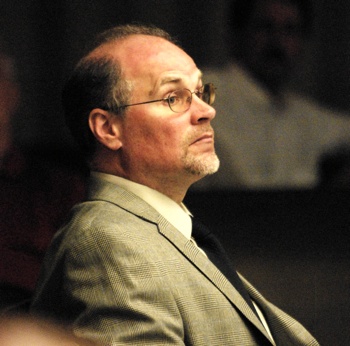
Cevin Taylor, an attorney representing the Jesuits who are seeking a special exception use to live at 1919 Wayne Street.
Masoud Kamali noted that he is married to a previous speaker, Elizabeth Kamali, and he also supported the request. Not everyone who supports it is Catholic, he added – he was born Muslim, and isn’t Catholic. He said he’s from Iran, describing it as a country that’s portrayed negatively by many. He’s very aware of being discriminated against because of association.
The attorney representing the Jesuits, Cevin Taylor, added verbal remarks to supplement the letter he submitted to the commission. [.pdf of Taylor letter] He thanked the planning staff for the professional way that they’ve handled this process. He and the Jesuits have heard the neighbors’ concerns and will do their best to take those concerns into account. He noted that many issues have been raised, but the planning commission’s task is to determine if the request meets the zoning code requirements. The code states that the requirements must be “substantially” met, he noted, so there’s some leeway.
Taylor also argued that a functional family shouldn’t be held to a higher standard than a biological family. In a biological family, a father might need to move to another city for a year for work reasons, Taylor said. Death, divorce, remarriage, the birth or adoption of children – all of these changes might happen in a traditional family. Regarding the word “society” in the “Society of Jesus,” the zoning ordinance doesn’t exclude any entity that has a legal name using that word, he said. Regarding the word “generally” that was used in the Jesuits’ request, Taylor said he takes blame for that. The application states that residents “will generally be members of the religious order that serve at St. Mary’s Student Parish…and/or will be pursuing degrees at the University of Michigan or other local institutions.” He said they will all be members of the order – one student, with the others serving at the parish. He concluded by asking commissioners to approve the application.
The final speaker was Ellen Ramsburgh, who serves on the city’s historic district commission. She said the objection isn’t to who is applying. Rather, it’s that the request would be granted to a group that is not a functional family. The group could find housing in several other zoning districts, she noted. The planning staff’s description of the Jesuits’ living arrangement also describes any of the co-ops that are run by the Inter-Cooperative Council, she said. Those are located in districts that allow this type of living arrangement. She also noted that the relationship among members of the Jesuits’ house is impermanent and subject to assignments from the head of the Society of Jesus. The bond is not to the family unit, but to the organization. Within a biological family, there are usually contractual or legal agreements, she added, like a marriage certificate. Those contractual agreements don’t exist in the case of the Jesuits, she concluded.
Jesuit Home on Wayne Street: Commission Discussion
Planning commission chair Kirk Westphal began the discussion by thanking speakers who commented during the public hearing, saying that commissioners depend greatly on their input. However, he added, the commission’s purpose is to look at petitions as they relate to city code.
The initial discussion lasted more than an hour, followed by a vote. At the end of the meeting – around midnight – commissioners took up the issue again, and ultimately postponed action.
This report summarizes and organizes the deliberations thematically.
Jesuit Home on Wayne Street: Commission Discussion – Legal Issues
Responding to a query from Kirk Westphal, planning manager Wendy Rampson explained that she’d been involved in developing the city code related to the “functional family” designation. The case of Delta Charter Township v. Dinolfo resulted from a violation of the township’s limit on the number of unrelated individuals who could live in a house. The Delta case involved a family plus six unrelated individuals of a religious organization who challenged that zoning limitation, Rampson explained. Ultimately, the Michigan Supreme Court heard the case and ruled that all communities must make accommodations for non-traditional families.
The term used to refer to these kinds of situations was “functional family,” she said. That term was adopted as part of the city of Ann Arbor’s code, as well as for other municipalities nationwide. In the mid-1990s, the city of Ann Arbor’s code was challenged in a case that went to the state court of appeals, which upheld the city code, she said. But there have not been any formal applications for the functional family designation until this one, she said. It was adopted into city code in 1991.
Ken Clein quipped that if it’s been almost 25 years with only one request, “there’s not a mad rush at this point.”
Jeremy Peters asked if granting this special exception use would set any kind of legal precedent for future, if other groups – religious or not – want to apply. City planner Alexis DiLeo replied that she didn’t think so. Each petitioner would have to state their case to the planning commission, she added. By their nature, special exception uses aren’t appropriate everywhere.
Jesuit Home on Wayne Street: Commission Discussion – Functional Family
Diane Giannola asked if the request was for six specific individuals, or for any Jesuit. Alexis DiLeo replied that it would allow any member of the USA Midwest Province of the Society of Jesus to live at that location. Giannola wondered if there was any stipulation about requiring members to live there for a certain period. There’s no durational requirement, DiLeo said.
DiLeo also clarified for Giannola that the special exception use (SEU) is attached to the address, not to the property owner. If the SEU is granted, it would apply as long as the residents meet the criteria of the SEU – for example, as long as the residents are Jesuits. The SEU lapses after two years, if its requirements aren’t met.
Giannola wondered how this would be different from a fraternity or sorority. DiLeo cautioned that she wasn’t as familiar with fraternities or sororities, but her understanding is that members reside in a house for one to four or five years while in school. They don’t make medical decisions for each other, or pool their income, or share their material possessions. If something happens, they’d probably call their parents, she said. DiLeo said her assumption is that co-housing works in a similar way. An SEU is made on a case-by-case basis, she noted.
Jeremy Peters asked how this functional family designation might apply to a same-sex couple with more than two adopted kids, who under Michigan law might be technically unrelated. DiLeo said it would likely be a strong case for the functional family designation. If people like that apply, their request would be evaluated based on the ties that bind them together, she said.
Ken Clein asked whether the city attorney’s office was in agreement with the planning staff’s assessment of the functional family designation in this case. DiLeo said the planning staff as a whole discussed it, and discussed it with the city attorney’s office. The city attorney’s staff knows that planning staff is recommending approval of the SEU, “and did not find any reason to object or advise us otherwise,” she said.
Clein clarified again that if the Jesuits moved out of that house, the SEU would no longer apply and any other group would have to seek a new SEU. Yes, DiLeo said – if a different family type moved in that needed an SEU, then they would have to apply for it. The SEU doesn’t transfer to a different address or to a different family type.
Bonnie Bona pointed out that if an individual member of the Jesuit community purchased the house from the Society of Jesus, the SEU would remain in effect. DiLeo again noted that the SEU is not tied to the owner – it’s tied to the family type that’s granted the SEU.
Bona also wanted to know what options were available for six unrelated people to live, regardless of whether they were considered a functional family. DiLeo replied that the options would be to live in residences located in any R4 zoning district or in the downtown districts, zoned D1 or D2.
The city code has three residential occupancy options, DiLeo explained: (1) the functional family designation; (2) a traditional family of any size; or (3) four unrelated residents, or up to six residents in R4 districts. If there are seven unrelated residents, their only option is to seek a functional family designation, she said.
DiLeo noted that these “residential occupancy” options – outlined in Chapter 55, Section 7 of the city code – do not apply to “rooming or boarding houses, fraternity or sorority houses, student cooperatives, emergency shelters, or convalescent homes.” Those types of arrangements are allowed as special exception uses in the R2B and R4 districts.
Kirk Westphal cautioned against using the rationale that there are other places the Jesuits could live as a reason for making the planning commission’s decision.
Eleanore Adenekan asked about the word “society” in the group’s name. When the planning staff and city attorney’s office reviewed this application, what did they think about that word, given that a functional family can’t be a “social society.” DiLeo replied that the Society of Jesus is a religious order.
Peters asked about the Jesuits’ commitment to each other, outside of their commitment to the religious order. Dan Reim, who would be the head of household, said there’s a long training period, when they learn a particular spirituality within the Catholic church. It focuses how they live their life, and what their mission is. All of that they share in common, he said, and their religion is lived out on a daily basis through their life together. They take vows of poverty, he said – that’s why they don’t own their own cars or homes. All salaries come into a common pot, he said, and expenses are shared.
Bona thanked them for coming forward, and for facing some harsh criticism. “I think we would all feel unfairly treated if we became suddenly responsible for every one of our distant relatives’ mistakes,” she said, referring to criticism of the Catholic church.
Bona noted that all families face conflicts, and wondered how the Jesuits dealt with that. Communication is key, Reim replied. They are focused on helping improve people’s lives. From a faith perspective, “we believe that’s through our encounter with Christ,” he said. By sharing and practicing their faith together, talking to each other and praying together, that works pretty well. He said they struggle like everyone else.
Bona said she was trying to get at the issue of family and permanence. In a co-op, if you didn’t get along with others, you could just move out. Reim replied that the Jesuits take a vow of obedience to the next-highest person in the religious order. That person is responsible for assigning you to wherever you might go. That vow means they don’t get to choose where they go or what they do, Reim explained. You have the option of leaving the order, he added, but he thought their vows encourage them to work harder on sorting things out.
Adenekan asked about their daily routine. Reim said they work morning until evening, with their most intense work at the parish occurring on weekends. Each person is assigned a day off during the week. There are other Jesuits who might visit them and stay at the house for short periods. Biological family members might also visit, he said.
Adenekan clarified with Reim that if one Jesuit brother moves out, another brother would come to take a similar role within the household. She likened it to a divorce and remarriage within a traditional household. In response to another query, Reim said he’s the official patient advocate for Ben Hawley, and Hawley is the patient advocate for Reim. That’s an important distinction between the Jesuits and a co-op housing arrangement, he said. Regarding the pooling of resources, when purchases need to be made, the brothers discuss it and reach a consensus, he said.
Adenekan wondered if the graduate student who’d be living there would be moving on after his studies. Reim said the student might move, or might stay and continue working at the parish. If the student moves, another student might come, he added – depending on if there’s a Jesuit who gets accepted into a university graduate program. Or another Jesuit who’s doing ministry at the parish might live there. In general, there won’t be more than six Jesuits living there, he said, and maybe less than five.
Jesuit Home on Wayne Street: Commission Discussion – Neighborhood Impact
Kirk Westphal asked staff to respond to concerns about the stability of the neighborhood and turnover.
Alexis DiLeo replied that the neighborhood is predominantly owner-occupied, single-family homes of traditional families. There aren’t many rental properties or student rentals. A family of any size or four unrelated people could live at 1919 Wayne without a special exception use. There would be no requirements about the type of unrelated people who could live there – that is, residents could be four unrelated students. The city doesn’t regulate the number of cars that residents own, she noted, but there is a residential parking permit program in that neighborhood. Any household is entitled to a total of five permits.
Responding to a query from Westphal, DiLeo said the functional family designation falls under the residential occupancy section of the zoning code. That section talks about types of family arrangements and number of people. It doesn’t talk about gender, age or other characteristics. Individual or family roles are not regulated for traditional biological families, she noted. So if a functional family designation is approved, there can be different types of individuals within that family.
Responding to a query from Westphal, DiLeo explained that the planning commission could add conditions to the special exception use. Those conditions might relate to the number of parking spaces, the number of people allowed to live there, or other issues, she said.
Jeremy Peters wondered if putting restrictions on residents – like student status, gender, or age – would violate federal fair housing laws. Planning manager Wendy Rampson indicated that the staff couldn’t answer that legal question on the fly. The point of a “functional family” designation was to allow for types of living arrangements that have traditionally been kept out of single-family neighborhoods, she said. Peters noted that density would increase only by two people, compared to the four unrelated people that would be allowed to live there otherwise.
Wendy Woods asked about the issue of property values. DiLeo suggested that residents could contact a realtor or property appraiser to ask about property values. The city code does speak to the need to preserve property values, she said. But as a functional family, in the eyes of the city they would be a single-family household. She’s certain that there are six-person traditional, biological families in that neighborhood, so she didn’t think it was an unreasonable size. Other special exception uses allowed in that neighborhood are churches and childcare centers. Types of uses that are considered inappropriate for single-family neighborhoods include restaurants or a home business that’s out of character with the neighborhood.
Given the location, DiLeo didn’t think a six-person “functional family” household was out of character with the neighborhood.
Westphal asked about the experience of other communities with this type of designation, and how it worked. DiLeo didn’t have information about specific experiences, but said she’d surveyed other communities’ code. Some have definitions that are almost identical to Ann Arbor’s, while others include the phrase “religious order” explicitly as a type of functional family.
Jesuit Home on Wayne Street: Commission Discussion – Parking
Kirk Westphal raised the possibility of requiring that more than two of the six cars should be parked at the adjacent church lot. Alexis DiLeo said she took the Jesuits at their word when they said they would be parking two cars in the garage and two cars in the driveway. The cars aren’t assigned to specific individuals, she noted – keys are kept in a bowl, and the person who needs to leave takes the first car at the end of the driveway. She said they indicated that they drive smaller vehicles.
Ken Clein noted that the Jesuits have lived on Ferdon for about 10 years. He wondered if the city had any complaints about parking at that location. Dan Reim, the head of household for the Jesuits, said they’ve have no complaints. He noted that the homeowner next to them asked that they not park in front of that home, and they’ve complied with that.
Eleanore Adenekan confirmed that because of the system the Jesuits use – not owning individual cars – they don’t have to deal with moving cars. They just take the one that’s most convenient to use. She asked if there would be any meetings there, or gatherings for ministry. No, Reim replied.
Jeremy Peters asked why the Jesuits had chosen this house, rather than a house located in areas that wouldn’t require a special exception use. Reim said they like their current house on Ferdon and wouldn’t leave, but it has only four bedrooms and a small guest room. They’ve outgrown it. The house on Wayne fits their lifestyle, he said. There aren’t many seven-bedroom houses, he noted, and they’ve been looking for quite some time. The bedrooms are an appropriate size.
Reim again apologized, saying he had no idea it would become such a big issue and take up so much of people’s time.
Jesuit Home on Wayne Street: Commission Discussion – Zoning Board of Appeals
Jeremy Peters asked staff to clarify why the special exception use request was being handled by the planning commission, not the zoning board of appeals. He noted that the question had been raised during the public hearing.
Alexis DiLeo replied that the city code is clear – the planning commission is the entity that determines whether a group is a functional family, and also is the entity that approves special exception uses.
Bonnie Bona asked if the ZBA has any role to play if the planning commission rejects this request. Wendy Rampson said the next step would be for someone to take the issue to circuit court. There’s been some case law in Michigan that encourages all administrative remedies to be pursued before taking it to court, she said. Some courts have held that to mean taking the issue to the ZBA, even though the ZBA has no jurisdiction. Rampson said she couldn’t say definitively that the issue couldn’t be brought to the ZBA, but in the normal course of action the next step would be circuit court.
Jesuit Home on Wayne Street: Commission Discussion – Enforcement
Bonnie Bona asked planning staff to explain what should be done if someone is violating the city code. Wendy Rampson confirmed that enforcement is complaint-driven. It’s very difficult in court to prove over-occupancy, because it’s the city’s word against that of the residents, she said. Enforcement for over-occupancy primarily takes place through the city’s rental housing inspection program. She’s heard there’s a concern about over-occupancy at the Vitosha Guest Haus Inn – saying that it might be that neighbors have contacted community standards about parking but planning staff haven’t been contacted about zoning issues there.
The approach would be to meet with the property owner and give them time to make corrections, she said. If they don’t, the city can write tickets for civil infractions – but then it’s up to the court. So the staff has tools, she said, but they’re not the easiest tools to administer.
Jesuit Home on Wayne Street: Commission Discussion – Conclusions
Diane Giannola said that this arrangement doesn’t seem like a functional family to her. It’s more of a cross between a fraternity and co-op. Members of fraternities and sororities have bonds for life, she said – they feel like family, but live in a larger group housing. A co-op lives more like a family, but it’s more temporary, she said. Because the special exception use applies to an entire religious group – and not six specific individuals – Giannola couldn’t think of it as a functional family.
She could see awarding the group a special exception use if there were no place else in the city. But many other zoning districts allow for six unrelated people to live.
Planning manager Wendy Rampson clarified that the code refers to functional family types, not individuals. It was clear when consulting with the city attorney’s office that the code does not require specific individuals to be designated a functional family. Giannola said there’s too much transiency, because in this case the SEU would apply to an entire religious order.
Kirk Westphal asked if there would be any way to put legal requirements on the term of residency, to regulate the transiency. Alexis DiLeo said she hadn’t seen any examples of that in other communities, and she’d need to consult with the city attorney’s office. Rampson added that it’s a very difficult question, and the federal fair housing and civil rights laws might play into it. The planning staff hadn’t explored this particular issue in depth, and they couldn’t provide an answer that evening.
Ken Clein said he respectfully disagreed with Giannola. It seems that the commission is bordering on holding the Jesuits to a higher standard than a six-member traditional family. It could quickly lead to a sense of discriminating against people like this, he said. In traditional families, there are divorces, and people leave home. To say that a traditional family is permanent might be overstated, he thought. This request meets his understanding of a functional family designation.
Regarding impact on the neighborhood, Clein didn’t think there’s any solid evidence that property values would be negatively impacted. The church next to the house probably has more impact than this group would. It’s important to handle the parking so that it won’t impact other residents, but he didn’t think it would be detrimental to the neighborhood.
Eleanore Adenekan agreed with Clein. As a realtor, she evaluates houses based on the condition of the house and the neighborhood, not on who lives there or how long they’ve lived there. Her daughter previously lived in that neighborhood, she said, and it’s a residential, family-friendly area. These Jesuits aren’t teenagers, she added. They know how to maintain a home, and she’s supporting their request. She said she’s listened to concerns and has empathy for that, but noted that the Jesuits are committed. Their vows won’t result in a transient lifestyle, she said. She reported that her son attended a Jesuit school in New York City, so she’s familiar with that order.
Wendy Woods also was supportive of the request, saying it met the definition of a functional family. The main difference is that for the Jesuits, there will be a cap on the number of people living there. A traditional family doesn’t have that same constraint. She hoped that if it was approved, there would be community healing. There were some unfortunate comments during the public hearing, she noted. Woods also noted that there had been some concern about students living there, but she cautioned against making generalizations about students.
Bonnie Bona said she’d been through the same “mental gyrations” that other commissioners have gone through, taking all the comments to heart. Her view is that the definition of functional family is the Ann Arbor Jesuit community, which is listed as the family type on the SEU resolution. Like a traditional family, members will come and go. She didn’t share Giannola’s concern. Bona felt very comfortable with the group of Jesuits, and with the idea that this SEU doesn’t set a precedent. Future requests will also be based on the city’s standards and criteria, not on precedent. She thought the Jesuits could be strong neighbors.
Westphal didn’t know if this would set a precedent if any other religious group came forward with a similar request. Legal documents like health care proxies give him comfort with this particular group functioning as a permanent unit, but is that something that other religious orders have? He said he was struggling with these issues, even though he was comfortable with this particular group.
Jesuit Home on Wayne Street: Commission Discussion – Initial Motion to Postpone
Kirk Westphal pointed out that this was the first time the commission had dealt with this functional family issue, and he wanted more time to research the experiences of other communities and to further consult with the city attorney’s office. He wanted to get more “comfort with making sure this fits everybody’s expectation with what we’ve agreed to hold ourselves to with the master plan and the stability of neighborhoods.” He said he felt ill-prepared to make a determination.
Jeremy Peters observed that one of the main concerns is permanence. He didn’t know if language could be crafted in the SEU to deal with that, or if that would be exclusionary under federal fair housing laws.
Peters moved to postpone the item to get more information from the city attorney’s office with regard to possible restrictions on turnover of residents, and other legal issues.
Westphal asked staff how long it might take to have discussions with the city attorney’s office. “Years and years,” DiLeo quipped. [The city attorney's office generally has a reputation for taking a long time to deal with requests.] She said they could start the next day, and with the goal of bringing something forward at the commission’s June 17 meeting.
Bonnie Bona supported postponement, “so when we do vote, we’re all comfortable.”
Wendy Woods wondered what postponement would do to the Jesuits’ plans to buy the house. Dan Reim reported that the Jesuits have committed a certain amount of money, which they’d lose if they withdrew the offer or couldn’t move ahead with the deal. They have a sales contract on the house, which is listed at $795,000.
When asked to weigh in, the property’s current owner, Steffen Urbaniak, said he wasn’t going to make a decision on the spot that night. He wasn’t clear about the commission’s decision-making process, and wanted to take some time to consider what it means for him and his wife. They’d had this offer for quite some time, and are planning to move to China on July 1. They don’t have other offers at this time.
Woods pointed out that the commission’s decisions have consequences. She wasn’t in favor of postponing. Eleanore Adenekan also opposed postponement, though she noted that the sales contract could be extended if both parties agree.
Ken Clein also weighed in against postponing, noting that the city attorney’s office has already reviewed the information prepared by the planning staff and didn’t have any problem with it. He thought a postponement might be the equivalent of a vote against it, because it could possibly kill the real estate deal.
Clein clarified with planning staff that six votes would be required to pass the special exception use.
Bona said if it’s postponed, she’d like to see it at the next planning commission meeting on June 17.
DiLeo again stressed that the planning staff worked one-on-one with the city attorney’s office in crafting the language of the special exception use resolution. It’s very specific to this particular situation, and she noted that the resolution is significantly longer than most resolutions. “I don’t know how much more the city attorney’s office even has to offer, relative to precedent-setting,” she said. She added that she could work with the attorney’s office regarding what kind of additional conditions might be included, beyond the current resolution.
DiLeo said it would help if Westphal could clarify exactly what he’d like to see as conditions. “Going to the city attorney’s office with open-ended questions, you don’t get the level of specificity that I think you might be looking for,” she explained.
Westphal replied that he was interested in restrictions that might address the degree of turnover among residents. He also wanted time for the Jesuits to meet with the Oxbridge Neighborhood Association.
Peters said he opposed postponement. He explained that he had moved to postpone becuase Westphal, as chair, couldn’t make the motion. Peters had wanted Westphal’s concerns to be discussed.
Outcome on initial vote to postpone: It failed on a 3-4 vote, with support from Kirk Westphal, Diane Giannola and Bonnie Bona.
Jesuit Home on Wayne Street: Commission Discussion – Additional Comments
Wendy Woods noted that the decision on the special exception use does not require city council approval. She confirmed that there would also be no recourse to take this item to the zoning board of appeals.
Outcome on granting the special exception use: It needed six votes to pass, and failed on a 5-2 vote over dissent from Kirk Westphal and Diane Giannola.
Jesuit Home on Wayne Street: Reconsideration
At the end of the meeting around midnight, during the agenda item for commission proposed business, Jeremy Peters said it might be worth looking at the bylaws regarding special exception use – especially considering that not all members of the planning commission were present for the vote. [Sabra Briere and Paras Parekh were absent.]
Planning commission chair Kirk Westphal noted that the commission did have the ability to take up items for reconsideration. “I sensed there was some degree of surprise with the vote,” he said.
Diane Giannola pointed out at an item can only be brought back for reconsideration by someone who voted on the prevailing side. In this case, that meant only she or Westphal could bring it back.
Planning manager Wendy Rampson read from the relevant section of the commission’s bylaws:
Section 12. After a motion has been decided, any member voting with the prevailing side may move for reconsideration of the motion at the same or the next regular meeting. No motion may be reconsidered more than once.
Bonnie Bona said she likes the fact that planning commissioners tend to vote their conscience, rather than taking a straw vote or negotiating votes, which she said feels like a political process. So it’s appropriate that they voted, and then can reconsider it if that’s what is desired.
Westphal noted that it’s rare to have two commissioners absent. He indicated interest in reconsideration. Saying that it was late – about midnight – Giannola proposed waiting two weeks until the June 17 meeting. It could be reconsidered at that time.
Bona thought the commission should act sooner, or the Jesuits might lose their sales contract for the property. Giannola pointed out that four people could live there without a special exception use – just not more. Westphal noted that the whole point of buying the house was that it would accommodate more people.
There was some discussion about another section of their bylaws, regarding acting on agenda items after 11 p.m. From the bylaws:
Article VII: Section 2. No agenda item will be taken up by the Commission after 11:00 p.m., except by the consent of five (5) Commission members present. In those cases where agenda items are not completed, they will be put forward to the next regular meeting of the Commission and placed first on the agenda.
For the previous hour, commissioners had followed this rule for other items on their agenda. Wendy Rampson noted that their current discussion was not actually an item on the agenda, but Bona wanted to go through the process so that there’d be no question that the vote to reconsider was official.
Outcome: Commissioners voted unanimously to extend the meeting to consider this item.
Westphal asked Giannola if she wanted to make a motion to reconsider. She did not. So Westphal then moved to reconsider the special exception use item for the house on 1919 Wayne St. He said even though waiting two weeks might jeopardize the sales contract, it benefited the community to have a more thorough discussion.
Ken Clein then moved to postpone the reconsideration. Rampson pointed out that commissioners hadn’t yet voted on the motion to reconsider. Clein withdrew his motion.
Outcome: Commissioners passed the motion to reconsider, over dissent from Diane Giannola.
Rampson reported that her computer had just stopped working. It was about 12:10 a.m.
Peters moved to postpone until the June 17 meeting.
Rampson said that the planning staff would notify people who attended the meeting about the commission’s decision. She asked if commissioners wanted to re-open the public hearing.
Giannola supported re-opening the public hearing, “since nobody’s here right now to see what we’re doing.” [Other than commissioners, planning staff and The Chronicle, no other people were at the meeting at this point.]
Westphal commented that it’s possible the planning commission would add conditions to the special exception use, which might change how some residents feel about it.
Bona also supported re-opening the public hearing. She asked Rampson to encourage the Jesuits and the Oxbridge Neighborhood Association to meet before the June 17 planning commission meeting, to try to address some of the residents’ concerns.
Westphal hoped to get some guidance from the city attorney’s office before June 17. Rampson said an updated staff report can be provided. It would be available online by the end of the day on Friday, June 13, as part of the June 17 meeting packet.
Westphal suggested that the Jesuits and neighborhood association could meet sometime after the updated staff report is available, but before June 17. Bona didn’t think that adding a bit of legal information would change the dynamic between the Jesuits and the neighbors. She cautioned against constraining when those groups should meet.
Woods agreed with Bona. She wondered if someone from the city attorney’s office could attend the June 17 meeting. Rampson said she’d ask, but typically the city attorney’s staff are reluctant weigh in at meetings, other than on questions of fact.
Westphal clarified with Rampson that a simple majority was required to pass a motion to postpone.
Outcome: On a 6-1 vote, commissioners postponed the item until June 17, over dissent from Diane Giannola.
Jesuit Home on Wayne Street: June 17 Meeting
After the vote, two commissioners who supported the request – Jeremy Peters and Eleanore Adenekan – indicated that they will be absent, and another supporter, Ken Clein, said he might also be unable to attend. So it’s possible that there will only be six commissioners at that meeting – which means all commissioners would need to vote yes in order for it to pass.
On Friday, June 13, the planning staff posted a revised staff report on this item, incorporating responses based on the June 3 discussion. The staff continues to recommend approval of this request. [.pdf of June 17 staff report]
North Maple Public Housing
Planning commissioners were asked to recommend approval of rezoning a 4.8-acre site at 701 N. Maple Road from R1C (single-family dwelling district) to R4B (multi-family dwelling district). Commissioners were also asked to recommend a site plan and development agreement for the project – part of a major renovation effort by the Ann Arbor housing commission. The site is on the west side of North Maple, between Dexter Avenue and Hollywood Drive.
The plan calls for demolishing 20 existing single-family homes – the public housing complex known as North Maple Estates – and constructing an eight-building, 42-unit apartment complex with a total of 138 bedrooms. The units range in size from one bedroom to five bedrooms.
The project would include a playground, community building and 73 parking spaces. According to a staff memo, the buildings would be located along a T-shaped driveway that connects to North Maple Road and Dexter Avenue. The drive extends northward toward Vine Court but does not connect with that street. There would be a new connection to Dexter Avenue through the remaining, undeveloped length of Seybold Drive. [.pdf of staff memo]
The project also requires the city to vacate a portion of the right-of-way for Seybold Drive. The surrounding land is owned by the housing commission, so if the right-of-way vacation is approved, the land would become part of the housing commission property. Planning staff recommended postponement on that specific action so that the request to vacate a portion of Seybold Drive’s right-of-way can be given proper public notice.
In general, the postponement on the North Maple Estates reconstruction was recommended to allow time to address several outstanding issues related to the project, and to draft a development agreement.
The reconstruction of North Maple Estates is part of an ongoing effort by the housing commission to upgrade the city’s housing stock for low-income residents. At the planning commission’s May 6, 2014 meeting, AAHC executive director Jennifer Hall had made a presentation about the initiative, which includes seeking private investors through low-income housing tax credits.
At that May 6 meeting, planning commissioners recommended rezoning for three AAHC properties: (1) Baker Commons, at the southeast corner of Main and Packard, from public land to D2 (downtown interface); (2) Green/Baxter Court Apartments, at the northwest corner of Green and Baxter roads, from public land to R4A (multi-family dwelling district); and (3) Maple Meadows at 800-890 S. Maple, from R1C (single-family dwelling district) to R4B (multi-family dwelling district). The rezoning for those sites was subsequently given initial approval by city council at its meeting on June 2, with a final vote expected later this month.
North Maple Public Housing: Public Hearing
During the project’s public hearing on June 3, four neighbors voiced a variety of concerns about the proposal, including traffic related to the new curbcut on Dexter Avenue, increased density, and security.
Laura Fisher told commissioners that she wasn’t concerned about the project in general, but she did have concerns about the proposed curbcut onto Dexter Avenue. At that spot, Dexter Avenue narrows from five lanes to two. She lives near the intersection of Dexter and Valley Drive, across from the proposed curbcut. A lot of people turn left from Dexter into Valley Drive, she said, so that’s another issue, and a lot more study needs to be done regarding traffic.
Fisher also noted that the foot and bicycle traffic has increased in that area over the past 10 years, especially after the opening of Plum Market and Aldi at the corner of Maple and Dexter. People walk along Dexter Avenue to get there, and they walk in the road because there’s no sidewalk. Currently, people from North Maple Estates also cross Dexter Avenue without using the light at Maple. The staff report about the North Maple Estates didn’t address these issues, she said.
Joyce Garrett lives on Allison Drive, directly west of North Maple Estates. She said there were several residents who were not notified of the February citizens participation meeting about this project. It appears that there will be a lot more people living on that site, she noted, and that all the buildings will be significantly closer to the property lines. She was concerned about the impact of construction, and about what kind of fence or other barrier would be put up to prevent people from crossing into her property. Now, a lot of people cut through her yard. There’s also a bright light on the back of the community center that shines into the back of her house. She hoped things like that would be changed. She also thought the city’s sanitary sewer line runs along her back fence, and she wondered if that would be excavated.
George Dentel also lives on Allison Drive. He wondered why the residents who are most affected by this planning commission meeting – the people currently living in North Maple Estates – weren’t notified about it. He’s talked with them and they were shocked, he said. The current homes there have neat yards and playgrounds. “We’ve been living peacefully with this development for 25 or 30 years or more,” he said. Dentel didn’t understand the motivation for this project. Was it financial? “It certainly can’t be for the benefit of residents,” he said. He wanted to know if there are legal measures that residents can take to oppose the project. Most of the people who live on Allison and Hollywood oppose this project, he concluded.
Another Allison resident, Mike Kvicala, told commissioners that his house is directly behind the basketball court. He referred to the staff memo’s mention of “conflicting land use,” and asked for an explanation. His understanding was that the project would cut down the trees and scrub, and he wanted clarification of that. The biggest concern of most nearby residents is the density, he said, which will double. He wondered why there were five-bedroom units. He said he’s seen news items about immigrants “stuffing grandma and uncles and aunts” into apartments.
Another concern is building materials, like using vinyl, and he wondered how it would be maintained. The housing commission historically has done a poor job of maintaining its properties, he said, with a “revolving door” of administrators. He disagreed with a previous speaker who said there hadn’t been problems with North Maple Estates. He said he’s rebuilt his fence twice after kids have knocked it down, and he’s had outbuildings destroyed. “I’m constantly having police actions, so I’m concerned about security.” With increased density, there will potentially be more problems, he said.
Three representatives of the housing commission and project team spoke during the hearing, and were on hand to answer questions. AAHC executive director Jennifer Hall told commissioners that there’s been a lot of deferred maintenance, and that’s why AAHC has taken on this overhaul of its properties. Some just need rehab, but “this particular site is not one of them” – it needs to be rebuilt.
The houses at North Maple Estates have problems with their original construction and site design, Hall said. Eight of the 20 units are located at the lowest part of the site and have problems with water infiltration. So demolishing the houses and building new units will be better for residents as well as for the surrounding neighborhood. She said there was an opportunity to increase affordable housing on the site. Currently there are 10 four-bedroom houses and 10 five-bedroom houses. The proposed site plan would have more units with fewer bedrooms, so there’s more of a mix, Hall noted.
Scott Betzel of Midwestern Consulting spoke next. He’s the project’s civil engineer. The site presents an opportunity to increase density, be connected to public transportation, and use the land in a better way than it currently is, he said. The units will be new, modern and efficient. They will be ADA compliant and alleviate flooding problems. A key feature will be stormwater management – there isn’t any on the existing site, he noted.
Regarding the new curbcut onto Dexter Avenue, Betzel reported that it was examined by the city’s traffic engineer, who thought it was safe. A new sidewalk will be added to connect with an existing sidewalk at the corner of Dexter and Maple. Regarding landscaping, he said the conflicting land use buffer is required to be a minimum of 15 feet, but it will be more than that between the adjacent residential properties to the west. The large trees will be preserved, and more evergreen trees will be added. He thought it would be a benefit to the neighborhood and to AAHC residents.
Architect John Mouat of the Ann Arbor firm Mitchell & Mouat began by noting that the color of the buildings as shown in the meeting packet will be different – not the olive green that’s on the rendering. He described how the apartments will be distributed in eight buildings so there won’t be one big building. The smaller units are located near the community building, while the larger units, which are intended for larger families, are closer to the playground. He noted that the site includes about a 20-foot drop from one side to the other, and a major goal for this project is to put the buildings on higher ground. The buildings will also have fairly large porches, he said, and there won’t be patios in the back. They’re trying to create a secure, friendly environment, Mouat concluded.
Hall wrapped up the commentary by adding that this project will include a community center so that AAHC will have on-site property management, which is not part of the existing complex.
North Maple Public Housing: Commission Discussion
Before discussion began, planning commissioner Wendy Woods announced that her husband, Ronald Woods, served on the housing commission board. Ronald Woods attended the June 3 meeting, but did not formally address the board. She said she personally did not benefit from the project, but would be willing to recuse herself if any planning commissioners objected. No one did.
Before the vote to postpone, discussion lasted about 35 minutes. Most of the commissioners’ questions related to issues that were raised during the public hearing.
North Maple Public Housing: Commission Discussion – Fencing, Landscaping
Diane Giannola asked about the fencing. AAHC executive director Jennifer Hall replied that the current fencing is probably inadequate in every housing commission site. It will be replaced, she said, and they can keep an eye on that to make sure it’s not torn down. Having an on-site property manager will make that easier to do.
Giannola wondered if it would be possible to build a six-foot-high wood fence around the site. Hall replied that she wasn’t sure AAHC owned the fencing, but they’ll look into it. The type of replacement fencing will depend on cost. “We can only do what we have enough money to do,” Hall said.
Bonnie Bona asked staff to give an explanation of requirements for the conflicting land use buffer. City planner Alexis DiLeo explained that a buffer is required when there are different types of adjacent land uses – in this case, single-family sites abutting a proposed multi-family development. The buffer must be at least 15-feet wide, with a designated number of trees. There must also be either a hedge, berm or wall. For this project, a hedge will be used. Existing plants can be used to meet part of the requirement, DiLeo noted.
Bona said that in previous projects, construction trucks have pressed down the soil, which later causes new plants to grow very slowly. She wondered whether construction equipment can be kept away from the buffer area. Scott Betzel of Midwestern Consulting noted that on this site, the buffer will be at the bottom of a slope, so the land there likely won’t be compacted. They’ll be planting 86 trees in the buffer along the west side and 107 bushes.
Responding to another query from Bona, Betzel said a large number of trees will stay in place at the north half of the site, as well as on the southern quarter. Those are where the highest-quality of existing trees are located, he said. They’ve tried to save as much of the trees and hedgerow as possible, he added.
North Maple Public Housing: Commission Discussion – Infrastructure
Responding to a resident’s concern about the sewer line, Scott Betzel said the closest sewer line appears to be about 30 feet away from any fence.
Bonnie Bona asked about plans for lighting on the site. Alexis DiLeo reported that a photometric plan showed that no light would spill onto adjacent properties, and the pole fixtures are all “dark-sky friendly,” which have shields and downward-directed light. That compares to the current “wall pack” lighting that includes visible fixtures and bulbs. Bona said she lives near a city streetlight that’s “pretty obnoxious.” She wanted to make sure that the lamp itself is shielded on the bottom.
Betzel said no wall packs are proposed for this site. He wasn’t sure how tall the lights would be. Bona noted that it’s an important issue, especially since the site’s density will be increased. “When we’re asking the neighbors to live with more, I think we have to give them more,” she said.
Regarding the neighbor’s complaint about the community center light, Jennifer Hall said she’d be happy to remove it now. The proposed new lighting would all be on the street – no lighting would be placed in back of the buildings. So there would be no lights near the surrounding neighborhood, she said.
Bona also asked about sidewalks within the site, next to where cars will be parked. She said she’s always concerned about the overhang of a vehicle that might reduce the width of a sidewalk. Betzel replied all sidewalks in front of parking are seven feet wide.
Wendy Woods asked about the proposed detention pool, and wondered how deep the water would be. It concerned her, because children would be in that area. Betzel said that most of the time, the ponds would look like sloped grassy areas, with wetland plants like cattails at the bottom. It would be no deeper than five feet during a 100-year storm, he said. It’s designed to drain within 24-48 hours. John Mouat added that the playground was designed to be further away from the detention ponds.
Responding to a query from Bona, Hall noted that the existing buildings have no insulation. There are constant sewage backflows because the pipes are smaller than the ones required now. AAHC is spending thousands of dollars annually for repair and cleanup. So the houses are beyond the point where they can be rehabbed. Hall pointed out that the investors are requiring that the new buildings meet Enterprise Green Communities standards, so they will be higher energy efficiency buildings.
North Maple Public Housing: Commission Discussion – Management, Security
Wendy Woods was glad there will be an on-site manager. She asked about security on the site. Jennifer Hall replied that she gets a monthly report from the Ann Arbor police department for calls to all of the public housing sites. She doesn’t see reports about calls to surrounding neighbors, however. Hall said police chief John Seto had told her that the public housing sites don’t draw more police calls than other neighborhoods. Woods said problems from increased density aren’t necessarily tied to income or social status, and she wanted people to keep that in mind.
Hall observed that the site has a strong slope on the west side, so the design doesn’t accommodate back porches. That might help with security issues. She also noted that the west side includes the lowest-density units. The higher-density units are clustered together in an area where there aren’t any adjacent single-family neighborhoods.
Jeremy Peters asked about the role of the on-site manager. Hall explained that currently, complex managers are based out of Miller Manor, which is several miles away. They hold office hours at North Maple Estates a couple of hours each week. What’s more, the current community center is actually a converted house. The new community center will have offices and meeting space, and a manager who’ll be there every day. There will be a broad range of activities offered there for both children and adults, Hall said.
North Maple Public Housing: Commission Discussion – Density
Bonnie Bona said she’s a little uncomfortable with the rezoning to increase density on this site. She thought that the housing commission had planned to keep the density unchanged.
She noted that the existing houses are 50 years old, but should have lasted 100 years. The city needs to know that the housing commission will take care of its properties. “The worst investment is for the city to keep doing this over and over again,” Bona said. She hoped the commission would do it right this time, even if it costs more upfront to do that.
Jennifer Hall explained that all the funding for public housing has come from HUD. The AAHC did an analysis about how much it would need to maintain its properties, and the amount is about three times more than what HUD provides, she said. Hall agreed with Bona, but said “I’m not made of magic – I can only use what funding sources are out there.” The advantage of the new financing approach, she added, is that there’s an opportunity to use private capital investment that’s not available for public housing. The private investors, including Chase Bank, want to ensure that their investment will last for the term of the agreement, which is a minimum of 20 years.
The process includes putting a portion of rent revenues into a capital reserve fund, Hall explained. That wouldn’t be possible with just 20 units, she added – there wouldn’t be enough funds to maintain the buildings, and they wouldn’t be able to get investors for the project. So the density is needed in order to make the project viable, she said.
Jeremy Peters confirmed with Hall that this would be the first addition to the city’s affordable housing stock in recent memory. Hall estimated that the city was losing 100 units of affordable housing each year. She noted that Avalon Housing recently opened an apartment complex on Pauline, but there are eight fewer units than in the previous apartment complex there.
Peters said that the city has made affordable housing a priority, yet there seems to be a struggle to add more units. That should be kept in mind when commissioners evaluate the increased density of this North Maple proposal, he said.
North Maple Public Housing: Commission Discussion – Traffic
Kirk Westphal asked about the traffic issues raised during the public hearing. Scott Betzel reiterated that he’d spoken with the city’s traffic engineer, and they both agreed that adding the Dexter Avenue curbcut seemed like a logical and conventional solution to the situation. Planning manager Wendy Rampson said that planning staff would follow up with the traffic engineer to take another look at it.
Jennifer Hall explained that the site requires a second exit for fire emergencies. One of AAHC’s concerns is that they don’t want it to be a cut-through street, so they’d be willing to look at adding speed bumps or other traffic calming measures.
North Maple Public Housing: Commission Discussion – Misc.
Ken Clein highlighted information in the meeting packet about housing costs, saying that it might be confusing. It was a sheet with rent and income data for “Maple/Platt,” which had been distributed at the citizens participation meeting in February. Jennifer Hall clarified that AAHC is also working on a project for a site on Platt Road. So this information showed a range of income levels to illustrate who would be eligible for AAHC’s housing. The information provided in this sheet also referred to 70 total units, which is the combination of proposed units on both the North Maple and Platt sites, Hall said.
Bonnie Bona directed staff to double-check the mailing addresses, to make sure all nearby residents are provided with adequate notification.
Hall offered to pass out her business card to residents who were interested in following up with her about the issues raised during the public hearing. She said she’d be willing to come out and meet with neighbors, if they wanted to set up a meeting.
Outcome: Commissioners unanimously voted to postpone the three items related to this AAHC request: Rezoning, site plan, and street vacation. The items are on the commission’s June 17 agenda for consideration.
Rudolf Steiner Expansion
The site plan for expansion of the Rudolf Steiner High School was on the June 3 agenda. The private school is located at 2230 Pontiac Trail, north of Brookside.
The project – estimated to cost $2.5 million – involves building a one-story, 19,780-square-foot addition to the existing classroom building. The building will include a 9,990-square-foot gym, with the remaining 9,790 square feet used for classrooms and storage.
According to the staff memo, an existing Quonset hut on the east side of the site will be removed, as will a 48-inch white oak tree immediately east of the proposed addition. The school will be required to plant 12 trees for mitigation. In addition, 17 new trees will be planted as part of the project.
Parking will be increased by 31 spaces to accommodate special events and discourage parking in nearby neighborhoods, according to the staff memo. A total of 32 bicycle parking spaces will be provided near the north entry to the new addition. No additional enrollment beyond the previously approved 120 students is proposed. The school has operated at that location since 2002.
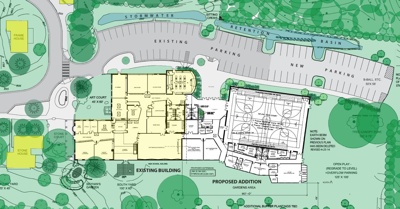
Site plan for Rudolf Steiner High School expansion. The yellow section is the existing building. The white section indicates the proposed addition.
Commissioners were also asked to approve a special exception use for the project. That’s required under Chapter 55 of the city’s zoning code because the site is zoned R1D (single family dwelling). Private schools are allowed within that zoning district, if granted a special exception use. The planning commission has discretion to grant a special exception use, which does not require additional city council approval.
The only speaker at a public hearing on this item was Dave Leclair of Livingston Engineering, the project’s site engineer. He introduced other members of the team, and said they were on hand to answer questions.
Rudolf Steiner Expansion: Commission Discussion
There was no discussion on the special exception use item.
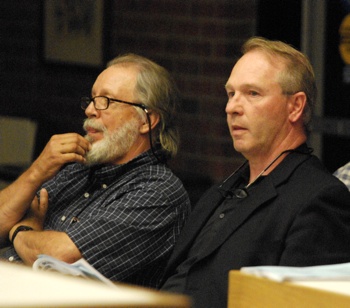
From left: Victor Leabu, facilities manager for the Rudolf Steiner High School, and Dave Leclair of Livingston Engineering.
For the site plan resolution, city planner Jeff Kahan told commissioners it had been amended to include the phrase “subject to a modified utility easement agreement addressing the proposed bioswale located within the easement area.” A water utility line is located under the bioswale. The city needs to have access to the water main, if it needs repair. If that happens, the owners of the property would be responsible for restoring the bioswale, which is about 6 inches deep.
Responding to a query from Ken Clein, Kahan explained that the school is proposing an additional 31 parking spaces that would extend the existing parking lot to the east. The intent is to accommodate overflow parking for school functions. Currently, overflow parking is on the lawn.
Also, the fire marshal recommends that emergency access be put in place to the street that’s south of the site. The fire marshal agreed that a gate could be placed there too, to prevent the emergency access from becoming a regularly used route to the street.
Kirk Westphal asked what kind of feedback the school has received from surrounding neighbors. Victor Leabu, the school’s facilities manager, said the school has been there about 12 years, and some of the families live in the neighborhood. Most of the feedback was positive, he said. One issue was that since the gym is higher and the lights might be on at night, someone wondered what the impact on the neighborhood might be. There aren’t any houses directly in that area, however, and the school plans to use shades on the windows at night, he said.
Outcome: In separate unanimous votes, commissioners granted the special exception use and recommended approval of the site plan. The site plan will be forwarded to city council for consideration.
Research Park Project
The June 3 agenda included a proposal to rezone six sites along Research Park Drive, as well as an area plan for development of the parcels.
Another item related to amendments to Chapter 55 of the city’s zoning code to allow outdoor recreation as a special exception use in the office/research/limited industrial (ORL) zoning district.
The six lots are undeveloped and total 16.6 acres. Four of the lots, on the southern end of the site, are owned by Qubit Corp. LLC; BMS Holdings LLC owns the northern two sites.
The rezoning would be from RE (research) to ORL. The proposed area plan – which is less detailed than a site plan – includes an indoor-outdoor tennis facility on one of the lots. It also includes five two-story buildings that could accommodate office, research, and limited industrial uses on the remaining lots, each with their own parking lot and access point to Research Park Drive.
Prior to construction, the project must go through the city’s site plan approval process, which might require a traffic impact study.
The text amendment to Chapter 55 would delete a current restriction that recreation sites must be within an enclosed building. The change would allow outdoor tennis courts to be built in the ORL zoning district.
Two people spoke briefly at the public hearing. Jim Barnwell of Desine Inc. and Laith Farjo, a representative of Qubit Group LLC, the site’s owner, introduced themselves and said they’d be available for questions.

Area plan for four sites in a proposed development on Research Park Drive. The image is oriented with east at the top.
Research Park Project: Commission Discussion
Responding to a query from Diane Giannola, planning manager Wendy Rampson said that commissioners had been briefed on the project at a working session last year.
Kirk Westphal asked what kind of feedback had been received, and if any changes are being considered based on the feedback. Laith Farjo, one of the owners, replied that everyone was very positive. Several people from surrounding businesses had attended the citizen participation meeting, he said, and liked the idea that the project would be bringing more life into that area. The hours are also complementary to existing businesses, he added. A juniors tennis facility would be the first phase, and would mostly be used in the evenings and weekends.
Outcome: In separate unanimous votes, commissioners unanimously recommended approval of the rezoning, area plan and amendments to Chapter 55 of the city’s zoning code. The items will be forwarded to city council for consideration.
Dusty’s Collision
A site plan for Dusty’s Collision at 2310 South Industrial Highway, south of Jewett, was on the June 3 agenda.
The proposal calls for building a 30,537-square-foot, one-story auto collision repair facility on a parcel that’s currently vacant. A previous building at that location was torn down in 2013. The new building would include 5,285 square feet for office use, a waiting area of 5,227 square feet, and 20,025 square feet for the repair area and garage. The project is estimated to cost $2 million.
The site will include 106 spaces of exterior parking, including 24 spaces that will be deferred until needed, according to the staff memo. One bicycle hoop – for 2 bike parking spaces – will be located near the front of the building.
The recommendation is contingent on the owner – Whitney’s Collision West of Ann Arbor – providing one footing drain disconnect before the city issues a certificate of occupancy. [.pdf of staff memo]
The only speaker at this item’s public hearing was Rich Henes, a principal with Cornerstone Design Inc., the project’s architect. He said he was there to answer questions.
Dusty’s Collision: Commission Discussion
Bonnie Bona said she couldn’t see much pedestrian access on the site – just the parking lot. She granted that it was a vehicle-centric business, but said that people might need to walk or take the bus there while their car is being repaired.
Rich Henes of Cornerstone Design said pedestrians could use the driveway, adding that it’s close to the road and there will be bike parking on the north corner.
Planning manager Wendy Rampson pointed out that there’s a sidewalk connection from the building’s entrance to the public sidewalk.
Jeremy Peters asked about plans to mitigate potential runoff from any hazardous materials that might be used. Henes replied that the building will have internal trench drains, with the runoff contained and disposed of legally.
Peters also asked about a comment in the staff report from the Mallets Creek Coordinating Committee: “The MCCC recommended that the petitioner consider conducting soil borings from the detention basin in order to increase infiltration design of the storm water basin. It is also recommended that the property owner take special care to monitor and contain any dripping fluids from damaged vehicles.”
Henes said the concern related to an existing bioswale on the north side of the property. The MCCC wants the owner to install a pipe that will direct runoff from that bioswale toward the center of the site. “But the water table is so high that it would be useless to do that,” Henes said. Rampson pointed out that the site plan complies with the county water resource commissioner’s current rules.
Ken Clein confirmed with the planning staff that the project’s landscaping plan meets the city’s requirements.
Outcome: Commissioners unanimously recommended approval of the site plan, which will now be forwarded to city council for consideration.
Communications & Commentary
Every meeting includes several opportunities for communications from planning staff and commissioners, as well as two opportunities for public commentary. Here are some highlights from June 3.
Communications & Commentary: Affordable Housing
Planning commissioner Jeremy Peters reported that he, Wendy Woods and Eleanore Adenekan met in late May with members of the city’s housing & human services advisory board and staff of the Washtenaw County office of community & economic development. It was the first in what will likely be a series of meetings regarding affordable housing. The intent is to look at issues where these three groups have similar interests, and eventually to provide some strong guidance for city and county leaders, he said.
Tentatively, Peters said, the group has identified four broad issues to discuss: (1) refining premiums offered to developers in the downtown D1 and D2 zoning districts; (2) investigating possible policy advocacy at the state level, to make the process of building or purchasing affordable housing units simpler and more predictable; (3) looking at actions to allow for workforce housing within the city in ways that are ultimately respectful of each neighborhood’s character; and (4) investigating what fee-based roadblocks might be modified or removed to make new construction of an affordable nature easier to do, in areas zoned for that type of residential development.
Communications & Commentary: Ordinance Revisions
Planning commission chair Kirk Westphal reported that the ordinance revisions committee had met immediately prior to the regular June 3 planning commission meeting, and continued discussion of possible changes to downtown zoning. No date has been set for the next ORC meeting. Members include Westphal, Bonnie Bona, Wendy Woods and Diane Giannola.
Present: Eleanore Adenekan, Bonnie Bona, Ken Clein, Diane Giannola, Jeremy Peters, Kirk Westphal, Wendy Woods. Also: City planning manager Wendy Rampson.
Absent: Sabra Briere, Paras Parekh.
Next meeting: Tuesday, June 17, 2014 at 7 p.m. in council chambers at city hall, 301 E. Huron. [Check Chronicle event listings to confirm date]
The Chronicle survives in part through regular voluntary subscriptions to support our coverage of publicly-funded entities like the city’s planning commission. If you’re already supporting The Chronicle, please encourage your friends, neighbors and coworkers to do the same. Click this link for details: Subscribe to The Chronicle.







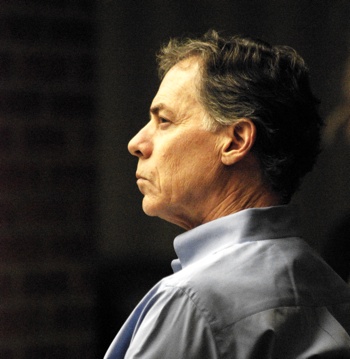
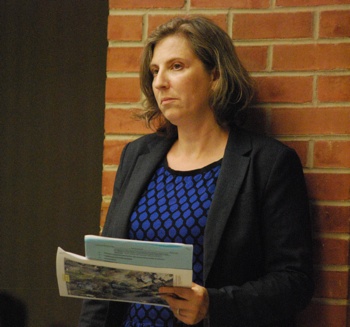



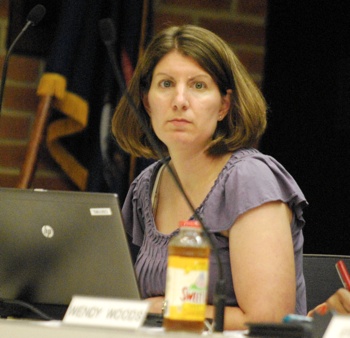

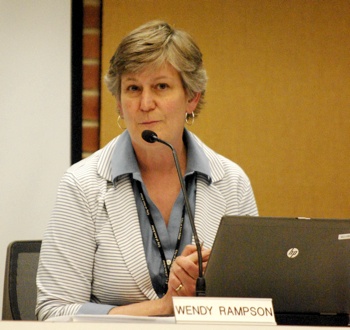

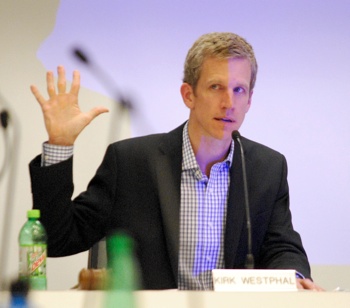
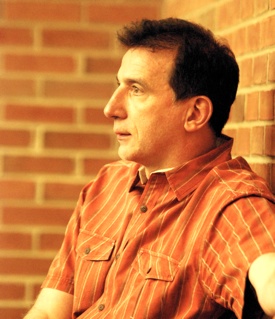
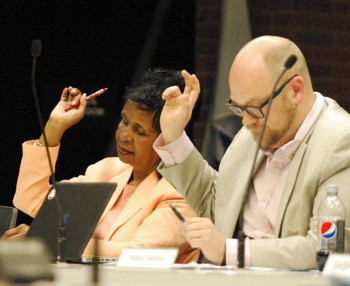
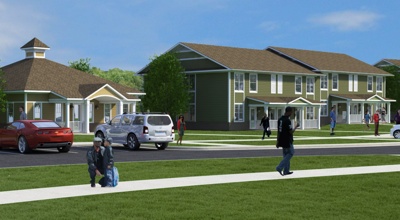
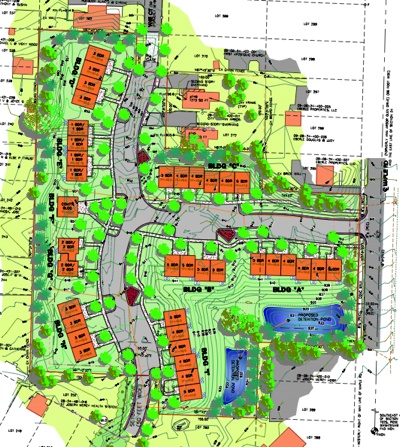
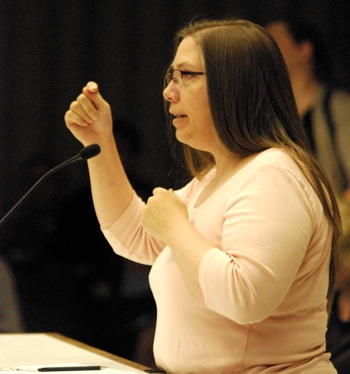
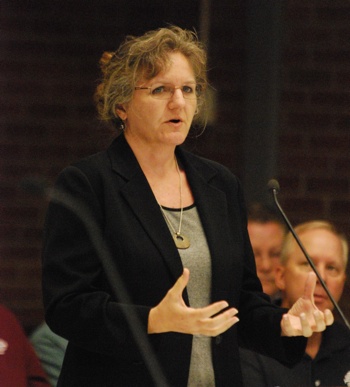
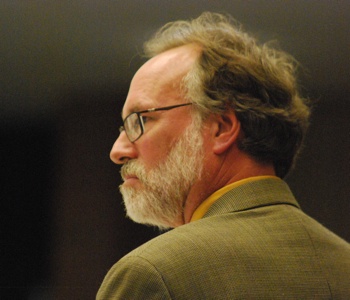
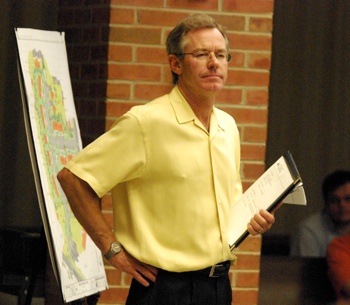


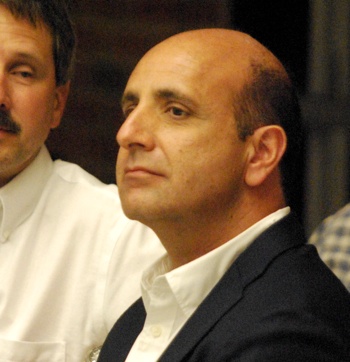

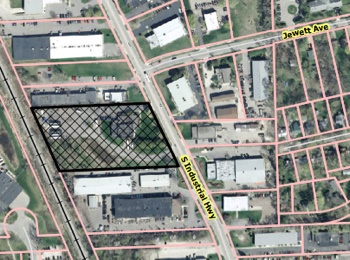
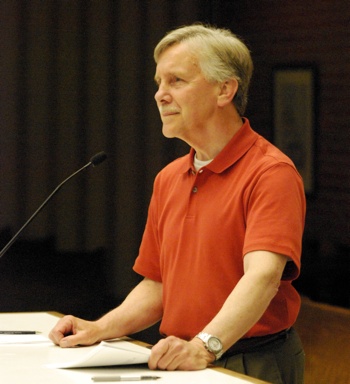
A look at the correspondence included in the planning commission’s June 17 meeting agenda on Legistar reflects the interest in the issue of the Jesuits’ request: 51 emails/letters. [link] Of the roughly half I’ve read so far, all are in support of granting the request.